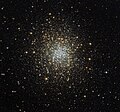Fichier:Palomar 2 Hubble.jpg

Gréisst vun dëser Duerstellung: 643 × 599 Pixel. Aner Opléisungen: 257 × 240 Pixel | 515 × 480 Pixel | 824 × 768 Pixel | 1.098 × 1.024 Pixel | 2.197 × 2.048 Pixel | 4.146 × 3.865 Pixel.
Original Fichier (4.146 × 3.865 Pixel, Fichiersgréisst: 10,9 MB, MIME-Typ: image/jpeg)
Versiounen
Klickt op e bestëmmten Zäitpunkt fir déi respektiv Versioun vum Fichier ze kucken.
| Versioun vum | Miniaturbild | Dimensiounen | Benotzer | Bemierkung | |
|---|---|---|---|---|---|
| aktuell | 08:38, 17. Abr. 2013 |  | 4.146 × 3.865 (10,9 MB) | Fabian RRRR | {{Information |Description='''Palomar 2 - A unique cluster: one of the hidden 15''' Globular clusters are relatively common in our sky, and generally look similar. However, this image, taken using the NASA/ESA Hubble Space Telescope, shows a unique ex... |
Benotze vu Fichieren
Dës Säit benotzt dëse Fichier:
Globaalt Benotze vum Fichier
Dës aner Wikie benotzen dëse Fichier:
- Benotzt op ar.wikipedia.org
- Benotzt op ckb.wikipedia.org
- Benotzt op cs.wikipedia.org
- Benotzt op de.wikipedia.org
- Benotzt op el.wikipedia.org
- Benotzt op en.wikipedia.org
- Benotzt op fr.wikipedia.org
- Benotzt op pl.wikipedia.org
- Benotzt op pt.wikipedia.org
- Benotzt op ru.wikipedia.org
- Benotzt op sv.wikipedia.org
- Benotzt op tr.wikipedia.org
- Benotzt op www.wikidata.org

